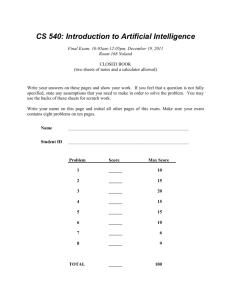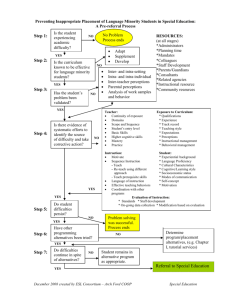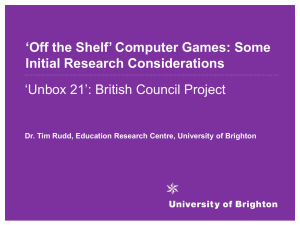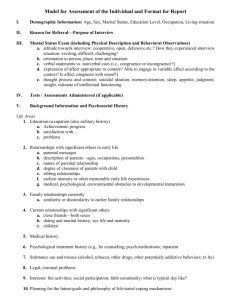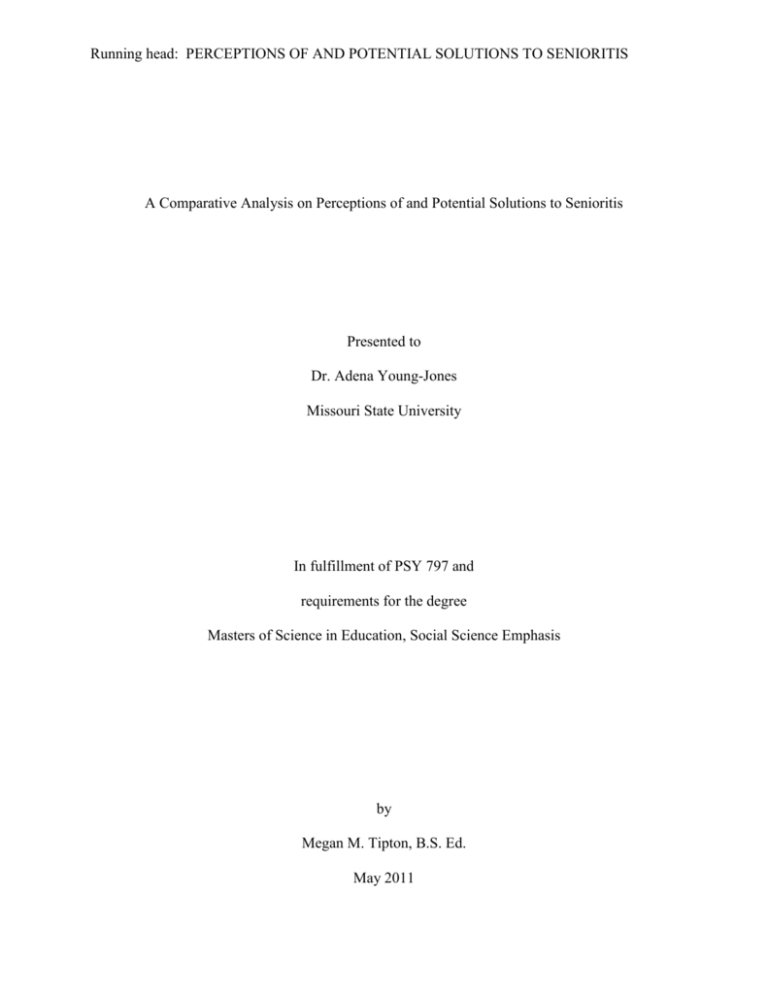
Running head: PERCEPTIONS OF AND POTENTIAL SOLUTIONS TO SENIORITIS
A Comparative Analysis on Perceptions of and Potential Solutions to Senioritis
Presented to
Dr. Adena Young-Jones
Missouri State University
In fulfillment of PSY 797 and
requirements for the degree
Masters of Science in Education, Social Science Emphasis
by
Megan M. Tipton, B.S. Ed.
May 2011
PERCEPTIONS OF AND POTENTIAL SOLUTIONS TO SENIORITIS
Copyright © 2011 by Megan Tipton
All Rights Reserved
2
PERCEPTIONS OF AND POTENTIAL SOLUTIONS TO SENIORITIS
TABLE OF CONTENTS
CHAPTER
PAGE
ABSTRACT
4
INTRODUCTION
5
Senioritis
5
Self-Determination Theory
6
Purpose of the Study
9
METHOD
10
Participants
10
Measures
10
Procedures
11
III
RESULTS
12
IV
DISCUSSION
16
Significance of the Study
16
Summary of Basic Findings
16
Implications and Potential Solutions
18
Limitations and Future Research
21
Conclusion
22
I
II
REFERENCES
23
TABLE 1
26
FIGURE 1
27
3
PERCEPTIONS OF AND POTENTIAL SOLUTIONS TO SENIORITIS
Abstract
Senioritis, characterized by a severe lack of motivation, afflicts students during their last year of
high school. This so-called disease continues to plague educators and parents alike specifically at
the high school level. Senioritis is pervasive in American culture and is evidenced by numerous
perceptions. In order to identify which perception is the most prevalent in a parochial high
school, quantitative data was accumulated from teachers and seniors at a Midwestern Catholic
high school. The data signified that students believed applying to college, lack of teacher
motivation, and parental pressure are all contributing causes of senioritis, and students gave these
factors more significance than teachers. In fact, students rated senioritis as a greater problem
than teachers. Additionally, ACT scores were shown to predict senioritis and students who had
higher levels of competency feelings also had lower ratings of senioritis.
4
PERCEPTIONS OF AND POTENTIAL SOLUTIONS TO SENIORITIS
CHAPTER I
Introduction
Senioritis, a term coined in the 1950s, invokes a sense of entitlement amongst senior high
school students while at the same time eliciting dread from both parents and teachers.
Characterized by a severe lack of motivation toward academia, senioritis is considered a disease.
Stereotypically, an afflicted senior is one who coasts through the last year of high school, only
taking courses that are required for graduation. The prevalence of senioritis in the American
education system illuminates the failure of effectively dealing with a group of students who need
the most guidance as they transition from high school into college.
Senioritis
Descriptions of high school seniors are similar across the nation. They are characterized
as lazy and entitled (Sizer, 2002), lacking focus, and generally indecisive (Keegan, 2006). While
the senior year is considered a rite of passage in American culture, it is also a tumultuous
emotional state for most students. They experience feelings of nostalgia, vulnerability,
restlessness, and disappointment (Sizer).
Senioritis is most prevalent during the transitional period between childhood and
adulthood. Seventeen and eighteen year-olds are usually more mature than their underclassmen
counterparts and, therefore, feel that school rules are arbitrary, diligence is unnecessary, and
graduation will occur regardless of their actions. Students are trying to figure out who they are
and who they want to be. It is a frightening and daunting quest that leaves many students
depressed, listless, and anxious. Revisiting Erikson’s (1968) concept of identity formation versus
role confusion among adolescents, it is during this crisis that senioritis occurs, but the crisis is
essential to the creation of self.
5
PERCEPTIONS OF AND POTENTIAL SOLUTIONS TO SENIORITIS
As senior high students rapidly approach adulthood, these teenagers feel that they have
outgrown high school even though a complete identity has not been formed. Therefore, seniors
expect to coast through their last year of high school. This is inconsistent with what actually
occurs because young adults are predominately egocentric. The inability to take another person’s
perspective coupled with demands of fair treatment alters former relationships between teachers
and underclassmen. Sizer (2002) noted that seniors began to demean the teachers who were
willing to take them seriously when they were younger; additionally teacher reports show that
their admiration for students’ progress wanes as seniors lose many of the good habits they had
previously displayed. Teachers feel they no longer know their students when they become
seniors and are dismayed when lessons learned over the previous years are instantly discarded.
Unfortunately, teachers are just as much at fault as the seniors because they enable students to
accomplish the minimum amount of course work to earn credit for the class. It is no wonder that
the United States lags behind other countries academically (Chmelynski, 2004).
Senioritis affects students in varying degrees. The most alarming consequence is seen by
the rise in freshmen college students taking remedial courses their first semester. At least 30
percent of entering college freshmen enroll and pay for remedial courses in which they do not
necessarily earn college credit (Michelau, 2002). According to Michelau, graduating seniors are
not effectively prepared for college, and remedial education has become commonplace at
colleges and universities.
Self-Determination Theory
Academic motivation is a key concept when identifying potential reasons for senioritis.
Self-Determination Theory (SDT) differentiates motivation between intrinsic, extrinsic, and
amotivation (Deci & Ryan, 1985). These types of motivation range from intrinsic being the most
6
PERCEPTIONS OF AND POTENTIAL SOLUTIONS TO SENIORITIS
self-determined, followed by extrinsic motivation, and ending with amotivation as the least selfdetermined.
Intrinsic motivation is characterized by high levels of internalized learning, where
students are satisfied with the activity itself, not necessarily the potential benefits that might be
earned after the activity has been completed. Students who have high levels of intrinsic
motivation learn for the sake of learning (Otis, Grouzet, & Pelletier, 2005). When people
identify a behavior’s value, they internalize it, perceive the behavior as autonomous (Deci &
Ryan, 2008), and the behavior is more readily displayed. This type of student is more likely to
value high school.
As students transition through school, learning becomes extrinsically motivated (Jang,
2008). Gone is the love of learning, replaced by the feeling that school is just something that has
to be done. Students no longer value the lessons being taught, as they fail to see the relevance to
their own lives. Instead, students are participating in school because they have to, not because
they want to (Otis, et al., 2005). Extrinsic motivation is divided into subcategories based on
varying degrees of self-determination (Deci, 1975).
Introjection is the least self-determined form of motivation. People act accordingly based
on the threat of punishment or the promise of reward. In these instances, people tend to feel
controlled by their behavior and do not seek to internalize it. Identification is a form of extrinsic
motivation that gives people a greater sense of autonomy because they have accepted the value
of a behavior. Lastly, the most self-determined form of motivation is integration. The value of
the behavior has been assimilated into the sense of self (Deci, 1975).
7
PERCEPTIONS OF AND POTENTIAL SOLUTIONS TO SENIORITIS
Senioritis can also be explained in terms of amotivation. According to Deci and Ryan
(1985), amotivation is a state where people, or students, cannot see the consequences or motives
of their behavior. If a student has no purpose in school, then the concept of school is devalued.
Research by Vallerand, Guay, and Fortier (1997) highlighted the correlation between academic
amotivation and high school drop-out rates.
SDT seeks to explain why a behavior occurs, not just identify a specific behavior. This is
accomplished as SDT incorporates basic psychological need as the basis for motivation.
According to Deci and Ryan (2000) the needs of competence, autonomy, and relatedness must be
fulfilled in order to foster motivation, especially intrinsic motivation. In regards to the school
setting, these needs are met through mastery of material, relationships between students and
teachers, and the students’ ability to decide their academic career while in high school.
Self-determined behavior is more likely to occur when a student is acting of their own
volition. Legault, Pelletier, and Green-Demers (2006) noted that students who are given the
opportunity to make decisions about their academic careers are more likely to be interested and
engaged during their senior year. Even though Ferrer-Caja and Weiss (2002) reveal through
their research that choices in classes or activities is not related to intrinsic motivation, autonomysupported students are more likely to be motivated in the classroom (Legault, et al., 2006).
Behavior is also influenced by nurturing relationships. Students who have caring
teachers and parents are shown to be more intrinsically motivated (Ryan, Stiller, & Lynch,
1994). These students are more likely to have a secure attachment to their caregiver and this
satisfies the need of relatedness (Bowlby 1979) as the students use this secure base to explore
their surroundings and enhance intrinsic motivation.
8
PERCEPTIONS OF AND POTENTIAL SOLUTIONS TO SENIORITIS
Additionally, the more likely a student is satisfied with their school, they are more likely
to develop scholastic competence. This sense of competence directly relates to the development
of self-esteem and higher life satisfaction (Danielsen, Samdal, Hetland, & Wold, 2009). In other
words, competence in school helps generate a positive sense of self. Furthermore, support from
teachers promotes school satisfaction (Jones, 2008) which in turn leads to students to feel
empowered (Frymier & Houser, 2000), thus increasing their level of motivation.
Purpose of the Study
The purpose of the study is to identify the perceived causes of senioritis and investigate
how senioritis is viewed by both students and teachers. It is a definite problem for parents and
educators, both who want to do what is best for their students but do not necessarily have the
tools to do so. Once the perceived causes are known, steps can be taken in order to dull the
pervasiveness of senioritis and change the way students approach their senior year of high
school.
It is hypothesized that significant differences will exist for the total senioritis score and
each item on the senioritis scale between students and teachers. Specifically, it is believed that
students will rate boredom, parental pressure, and the pressure of applying to college as
significantly greater contributors to senioritis than teachers. In addition, it is hypothesized that
higher ratings of the basic needs will predict lower levels of senioritis.
9
PERCEPTIONS OF AND POTENTIAL SOLUTIONS TO SENIORITIS
CHAPTER II
Method
Participants
This study included 88 senior high school students from a Catholic high school in
Midwestern Missouri. Of these students, 49 percent were males (n = 43), 51 percent were
females (n = 45), 100 percent plan on attending college; the average ACT score is 26, with a
1,987 on the SAT, and a 3.73 GPA. In addition 24 teachers, which comprise 96 percent of the
faculty, completed the senioritis survey.
Measures
Likert scale questionnaires were developed to determine perceptions of senioritis. The
Senioritis Inventory explored the definition of senioritis, identified who is impacted by senioritis,
and investigated possible contributing factors of senioritis based on perceptions of both teachers
and senior high school students. Students and teachers received equivalent versions of this
inventory. Additionally, a demographic survey was created to collect objective and descriptive
information such as classification, ethnicity, ACT/SAT score; demographic data was not
collected for teachers.
The Basic Psychological Needs Scale assessed need satisfaction in the domains of
autonomy, competence, and relatedness. For instance, participants rated their feelings of
competence, evaluated relationships and freedom of expression, and identified the acquisition of
new skills. The internal consistency of the subscales is acceptable, ranging from .58 to .80
(Ilardi, Leone, Kasser, & Ryan, 1993). The Learning Climate Questionnaire evaluated the
perceived relationships between a student and their teachers. For example, participants identified
whether they feel competent in the school environment, feel trusted by teachers, and feel that
10
PERCEPTIONS OF AND POTENTIAL SOLUTIONS TO SENIORITIS
their ideas and beliefs are listened to by teachers. The internal consistency of the subscales is
acceptable, ranging from .58 to .80 (Williams & Deci, 1996).
Procedures
This voluntary study was carried out during a normal school day and took approximately
20 minutes to finish. Student participants completed the questionnaires at will during their
theology class. Teacher participants were asked to complete the Senioritis Inventory and return
their results when convenient.
11
PERCEPTIONS OF AND POTENTIAL SOLUTIONS TO SENIORITIS
Chapter III
Results
Responses from 88 students and 24 teachers to the senioritis survey were examined to
determine if there was a significant difference between the responses of students and teachers.
Data was screened for missing data, outliers, and assumptions and found to be multivariate
normal, linear, and homogeneous. Four participants were eliminated due to missing data, and
two were found to be outliers using Mahalanobis distance (X2 (9) = 27.88) leaving a total of 106
participants, 23 teachers and 83 students.
A one-way ANOVA determined the total senioritis score and the score for each response
on the survey. Regarding many of the various aspects of senioritis, no significant difference
existed between students and teachers. Specifically, no differences were found regarding the
description of senioritis f(1,105) = 0.298, p = .586, the severity of the problem posed by
senioritis f(1,105) = 1.004, p = .319, the importance of combating senioritis f(1,105) = 1.366, p =
.244, the effects of boredom on senioritis f(1,105) =1.853, p = .176, and the similarity of the
problem of senioritis for all students f(1,105) = 1.045, p = .309. However, there was a significant
difference between students and teachers with regard to the pressure of applying to college
f(1,105) = 14.481, p < .001, the lack of motivation among teachers f(1,105) = 5.612, p = .020,
and the pressure placed on students by their parents to succeed f(1,105) = 4.927, p = .029.
Finally, there was also a significant difference overall between the responses of students and
teachers f(1,105) = 20.544, p < .001. These differences are shown in Table 1.
A post hoc analysis was carried out using an independent samples t-test examining the
pressure of applying to college, the lack of motivation among teachers, the pressure placed on
students by their parents to succeed, and the overall difference in responses between students and
12
PERCEPTIONS OF AND POTENTIAL SOLUTIONS TO SENIORITIS
teachers. Post hoc results are shown in Table 1. The post hoc examining the pressure of applying
to college showed that students (M = 3.66, SD = 1.564) rated it as a larger contributing cause of
senioritis than did teachers (M = 5.09, SD = 1.676), t(104) = -3.805, p < .001. The post hoc
examining the lack of motivation among teachers showed that students (M = 5.87, SD = 1.140)
rated it as a slightly larger contributing cause of senioritis than did teachers (M = 5.02, SD =
1.600), t(104) = -2.369, p = .020. The post hoc examining the pressure placed on students by
their parents to succeed showed that students (M = 4.54, SD = 1.670) rated it as a larger
contributing cause of senioritis than did teachers (M = 5.39, SD = 1.438), t(104) = -2.220, p =
.029. Finally, the post hoc examining the overall difference in responses between students and
teachers showed that students (M = 3.79, SD = .607) rated senioritis as a greater problem than
did teachers (M = 4.41, SD = .479), t(104) = -4.533, p < .001.
Using a Mahalanobis distance of 18.47, three outliers were found and eliminated from the
analysis. A one-way ANOVA was carried out on the remaining 85 participants examining the
relationship between the learning climate, basic needs autonomy, basic needs competence, and
basic needs relatedness with the overall score on the senioritis measure. The learning climate
score was found to be not statistically different from the senioritis score f(24,84) = .641, p =
.885. The basis need of autonomy was found to not be statistically significantly different from
the senioritis score f(24,84) = 1.303, p = .203. Relatedness was also found to not be statistically
significantly different from the senioritis score f(24,84) = 1.292, p = .210. However, the basic
needs of competence was found to be statistically significantly different from the senioritis score
f(24,84) = 2.009, p = .015. A paired samples t-test was carried out to examine the difference
between the basic needs competence and senioritis score. This showed that students scored
significantly higher on the competence dimension of the basic needs measure (M = 5.0678, SD =
13
PERCEPTIONS OF AND POTENTIAL SOLUTIONS TO SENIORITIS
.66184) than they did on the senioritis measure (M = 3.7716, SD = .61459) t(84) = -15.098 p <
.001. This shows that students who had higher levels of competency feelings had lower ratings of
senioritis.
A regression analysis was also used to find predictors of senioritis from the demographic
questionnaire, the learning climate survey, and the basic needs survey. The data was checked for
assumptions and outliers, and three participants were identified as outliers using Mahalanobis,
Cooks, and Leveraged distances and were excluded from the analysis. Each variable was entered
separately into a hierarchal regression to examine predictors of senioritis. Overall, this model
was not significant, indicating that these variables do not predict senioritis F(7,72) = 1.547, p =
.165, R2 = .131. ACT score was the only predictor of senioritis b = .046, t(72) = 2.808, p =.006,
pr2 = .092, showing that those with higher ACT scores reported stronger feelings of senioritis.
Multidimensional Scaling was used to analyze the questionnaire dealing with students’
perceptions of the causes of senioritis. Because all the questions were on a seven point Likert
scale, Euclidean distance was analyzed between the variables. One dimension and two dimension
models were produced with the two dimensional model (R2 = .95) having better fit than the one
dimensional model (R2 = .87). Figure 1 depicts the two dimensional model.
Generally, questions regarding the teachers creating a classroom environment where the
student feels comfortable (i.e., teachers handle emotion well, trust students, accept opinions, etc.)
and supported (i.e., give students choices, understand students, are open with students, etc.) were
grouped together. More negative questions such as poor teaching, senioritis being a major
problem, being forced to do what others say, boredom etc. were grouped in the same quadrant.
Questions involving intrinsic aspects such as free decision making, feelings of accomplishment,
parental pressure, etc. grouped into the same quadrant. Finally, questions concerning perceptions
14
PERCEPTIONS OF AND POTENTIAL SOLUTIONS TO SENIORITIS
of others (i.e., others care about me, classmates consider me a friend, people are friendly, etc.)
were grouped into the same quadrant as feelings of accomplishment and competency. This model
seemed to indicate that questions about the classroom environment and intrinsic versus extrinsic
influences separated into distinct groupings in the data.
15
PERCEPTIONS OF AND POTENTIAL SOLUTIONS TO SENIORITIS
CHAPTER IV
Discussion
Significance of the Study
The potential value of this research is to instigate a substantial change in the education of
senior high school students. As senioritis continues to permeate academia, students are no longer
what they once were. Many have to take remedial courses as they begin college, and the United
States is lagging behind the educational success of other countries mainly due to a failing system
that caters to students who lack higher levels of motivation. The data collected from this
research sheds light on the reasons why senioritis continues to plague parents and educators.
Awareness about the perceptions of senioritis could potentially foster discussion that would
change the way students’ transition out of high school and, thereby, potentially change the
overall dynamic of American education.
Summary of Basic Findings
This study is quantitative in nature, studying perceptions of two groups of people
regarding a single concept. These perceptions are influenced by a variety of factors. From the
students’ standpoint, their overall psychological well-being and understanding of the educational
process directly contributes to how they define, describe, and feel about senioritis. On the other
hand, teachers are relying on experience and day-to-day observations.
Data was collected from a parochial college-preparatory school located in Midwestern
Missouri. The school enrolls approximately 350 students per year, ninth through twelfth grade,
and boasts averages above the local and state levels. While these numbers are indeed high, it
does not prevent the school from having to deal with senioritis.
16
PERCEPTIONS OF AND POTENTIAL SOLUTIONS TO SENIORITIS
Results revealed that the hypotheses were partially supported. Students believed applying
to college, parental pressure, and a lack of teacher motivation were greater contributing factors to
senioritis than did teachers. Additionally, students rated senioritis as a greater problem than did
the teachers, acknowledging that they felt like it was more of an issue. Interestingly, the data
showed students with higher ACT scores reported stronger feelings of senioritis, but students
with higher levels of competency feelings had lower rates of senioritis. The basic needs of
autonomy and relatedness were found to have no statistical significance. Surprisingly, boredom
was not identified as a factor.
Applying to college requires an extensive amount of time and effort on behalf of the
student. Their high school career has been geared towards graduation and acceptance into
college, and as they get closer to their goals, they relieve stress by exhibiting symptoms of
senioritis. In fact, parental pressure can also be seen as a stress creator and therefore lead the
student to engage in behaviors that are indicative of senioritis.
Lack of teacher motivation as a contributing factor is a curious finding. This could mean
that teachers do not want to deal with students who display symptoms of senioritis.
Consequently, this creates an environment that caters to those particular students. Or this finding
might indicate that these feelings of apathy not only affect the students, but the teachers as well.
Boredom was not a statistically significant contributing factor to senioritis, as was
hypothesized before the study, but current research indicates that it should have been. Boredom
is directly related to the satisfaction of a student’s basic psychological needs as identified by
Deci and Ryan (1985), and it leads to the deskilling of both students and teachers (Kanpol,
1999). Teachers and faculty members of this parochial school are engaging students on various
levels, and therefore, students did not report high feelings of boredom.
17
PERCEPTIONS OF AND POTENTIAL SOLUTIONS TO SENIORITIS
The most fascinating result from this study was that students with higher ACT scores
reported greater feelings of senioritis. Students with high ACT scores tend to be ones who are
academically successful, and this does not correlate with the current research on senioritis.
Students who feel more competent in academia should not have or have fewer symptoms of
senioritis, because they have good mastery of educational content and overall higher life
satisfaction (Danielsen, et al., 2009).
Implications and Potential Solutions
While some of the results from this study were surprising, it does lend some explanation
for the reasons why senioritis is pervasive. The way the education system is currently set up is
not diminishing senioritis; it is in fact, perpetuating it. Society demands that students get good
grades in school and go on to higher academic institutions in order to be successful. This has
created a process that is not necessarily conducive to education itself. The focus has gotten away
from learning, which can be attributed to not only students, but teachers and parents too.
If there are not significant changes to the last year of high school, senioritis will continue
to prevail, and it is the entire education system that will suffer (Kantrowitz & Wingert, 2000).
Ultimately, seniors need to be challenged, they need to interact with adults, and they need to be
given opportunities that are not restricted to the classroom (Dreis & Rehage, 2008). Possible
solutions to senioritis include study abroad programs like GlobalQuest (Hoover, 2003), limiting
class sizes, or potentially changing the start time of school to later in the morning (Ch’en, 2001).
As mentioned previously, there are a variety of techniques used by schools to combat
senioritis. Even though senioritis continues to persist, these programs, if used correctly, move
schools towards an eradication of the overlying problem: a lack of motivation. For example,
Advanced Placement or dual-credit classes have been adopted in order to give seniors the
18
PERCEPTIONS OF AND POTENTIAL SOLUTIONS TO SENIORITIS
opportunity to earn college credit before they leave high school (Chmelynski, 2004). Other
schools allow their seniors to graduate early if all credits are earned with passing grades (D’Orio,
2002). Currently, what seems to be the most effective strategy is for high schools to develop
senior projects, internships, or community service programs. These allow seniors to branch out
from the everyday routine of high school, while learning valuable information.
Developing a program for senior projects is time consuming, but ultimately beneficial
(Hoover, 2003). According to Grubb (1995), a senior project consists of a major research
question, which the student attempts to answer over the course of their final year, followed with
a paper, and final presentation of the subject in question. Senior projects do not necessarily need
to be created by academic supervisors or teachers. Students can be just as effective in the
shaping and completion of inquiry-based research, as is evident in The Independence Project.
The Independence Project, developed by eight students in Western Massachusetts,
implemented an inquiry-based curriculum for their senior year (Engle, 2011). This project
enabled them to work at their own pace and ask questions of interest, as well as taught the
students how to work together, and what it means to really learn for the sake of learning (Engle,
2011). Wise Individualized Senior Experience (WISE) is also a popular program employed by
schools nationwide. A not-for-profit internship initiative, WISE helps seniors earn college credit
upon completion of unpaid internships in their areas of interest (Keegan, 2006).
College Admission offices are likewise making strides to reduce the negative impact of
senioritis on the collegiate freshman year. Colleges make it clear that acceptance is contingent on
maintaining grades throughout the second semester of high school senior year (Chmelynski,
2004). Senioritis might also be curbed if colleges required students to take exams that showcased
subject matter learned during their last year of high school (Michelau, 2002); in other words,
19
PERCEPTIONS OF AND POTENTIAL SOLUTIONS TO SENIORITIS
students would have to prove, through formal assessment, that they did not completely disregard
their senior year. Furthermore, colleges can withdraw acceptance when students fail to achieve
at the same level before they turned in their college applications (Viadero, 2001). This failure is
characterized by high absenteeism, a significant drop in grades, and possibly a large number of
dropped classes at the high school level (Mamlet & VanDeVelde, 2009).
As the literature reveals, a variety of techniques can be employed at this particular
parochial college-preparatory school in order to combat symptoms of senioritis. Currently, the
school offers a Senior Career Exploration Internship where students are able to work in an area
of interest that could potentially lead to a career. Students have worked at doctors and
veterinarian offices, special needs classrooms, and law firms. Interns are required to be a senior
with at least twenty-four credits to enroll in the program. However, this program does need
improvement. Students are allowed to choose where they want to intern and with whom.
Because these students are seniors, many have chosen their parents, who allow them to go home
and take naps instead of learning a career path. The school needs to create a program where the
Academic Advisor helps select the internship that will be completed by the student. Moreover,
the Academic Advisor should have a greater role in assessing the student in their chosen field of
study.
In addition to the internship program, teachers need to approach the senior year of high
school differently. The data showed that the teachers are lacking motivational skills in the
classroom. Seniors need to be challenged, intrigued by possibilities, and given more
responsibility. This has been shown through numerous studies and gathered empirical evidence
on motivation.
20
PERCEPTIONS OF AND POTENTIAL SOLUTIONS TO SENIORITIS
Students’ sense of self-efficacy and volition need to be addressed by the faculty.
Creating a senior project would do this. Senior projects allow the student to choose their own
topic, enhancing autonomy; then, they could create a presentation that covers many content
areas, showing an overall competency on the subject being researched. The project would be
overseen by a team of teachers who will continually advise the student and provide support,
which directly contributes to relatedness needs. Furthermore, allowing students to direct the
flow of material taught in the classroom is also another way to stem feelings of senioritis.
In addition to addressing high school seniors, teachers also need to be targeted.
Particularly, teachers need to be excited about the material presented in class and they need to be
able to relate the material to the students. Teachers need to find new and innovative ways to
foster subject-inquiry and intrinsic motivation (Deci & Ryan, 1985). This will mean more work
on the teacher’s part, but it is a step in eliminating senioritis and creating an environment that is
conducive to learning instead of hindering progress.
Limitations and Future Research
Limitations identified in this study included little diversity in participants because the
data collected was from the senior class of one high school, specifically a small Catholic school,
and there were also problems with the surveys themselves. For instance, not everyone filled out
the surveys, many students did not correctly complete portions of the Demographic Survey (e.g.,
Ethnic Group), and some students did not read the scale correctly on the Learning Climate and
Basic Psychological Needs Questionnaires. Consequently, all scores are not completely
accurate.
Future research should evaluate the manner in which the Learning Climate and Basic
Psychological Needs Questionnaires were incorrectly filled out which could lead to research on
21
PERCEPTIONS OF AND POTENTIAL SOLUTIONS TO SENIORITIS
other symptoms of senioritis. Furthermore, taking into account that higher ACT scores were a
contributing factor of senioritis from this study, it could be beneficial to look at the different
underlying causes of senioritis between parochial, private, and public high schools. The effect of
stress on the development of senioritis would also be a beneficial area for further research and
study.
Conclusion
As graduation time approaches, teachers and administrators breathe a sigh of relief as
they are granted a reprieve from seniors until the new school year begins. This cycle is
seemingly unbreakable because teachers, administrators, parents, and the students allow it to
continue. Senioritis has become the norm in high school, and unfortunately it has directly
contributed to the increasing number of incoming college freshmen that cannot pass a basic
algebra class or who cannot correctly write a paper. The main consensus among those involved
in the American education system is that reform is long overdue for seniors (Jayson, 2005). By
challenging the persistence of senioritis, high school students will be held more accountable for
their own education, and at the same time they will be more prepared for the challenges to come
in their lives.
22
PERCEPTIONS OF AND POTENTIAL SOLUTIONS TO SENIORITIS
References
Bowlby, J. (1979). The making and breaking of affectional bonds. London: Tavistock.
Ch’en, D. (2001 April). Senioritis has set in. NEA Today, 19, 7, 7.
Chmelynski, C. (2004 January). Save senioritis with serious senior studies. Education Digest, 69,
5, 33-37.
Danielsen, A. G., Samdal, O., Hetland, J., & Wold, B. (2009). School-related social support and
students’ perceived life satisfaction. The Journal of Educational Research, 102, 4, 303
318.
Deci, E. L. (1975). Intrinsic Motivation. New York: Plenum Press.
Deci, E. L., & Ryan, R. M. (1985). Intrinsic motivation and self-determination in human
behavior. New York: Plenum Press.
Deci, E. L., & Ryan, R. M. (2000). The “what” and “why” of goal pursuits: Human needs and
the self-determination of behavior. Psychological Inquiry, 11, 4, 227-268.
Deci, E .L., & Ryan, R. M. (2008). Facilitating optimal motivation and psychological well-being
across life’s domains. Canadian Psychology, 49, 1, 14-23.
D’Orio, W. (2002 October). Searching for the cure to senioritis. District Administration, 38, 10,
27-30.
Dreis, J., & Rehage, L. (2008 October). Recasting the senior year. Education Digest, 74, 2,
34-38.
Engel, S. (2011 March 13). Let the kids rule the school. The New York Times. Retrieved March
16, 2011, from http://nytimes.com/2011/03/15/opinion/15engel.html
Erikson, E .H. (1968). Identity: Youth and crisis. New York: Norton.
23
PERCEPTIONS OF AND POTENTIAL SOLUTIONS TO SENIORITIS
Ferrer-Caja, E., & Weiss, M. R. (2002 Fall). Cross-validation of a model of intrinsic motivation
with students enrolled in high school elective courses. The Journal of Experimental
Education, 71, 1, 41-65.
Frymier, A. B., & Houser, M. L. (2000). The teacher-student relationship as an interpersonal
relationship. Communication Education, 49, 207-219.
Grubb, W. N. (1995). Education through occupations in american high schools volume 1:
approaches to integrating academic and vocational education. New York and London:
Teachers College Press.
Hoover, E. (2003 June 27). Fighting ‘senioritis.’ Chronicle of Higher Education, 49, 42, A30.
Iladri, B. C., Leone, D., Kasser, T., & Ryan, R. M. (1993). Employee and supervisor ratings of
motivation: Main effects and discrepancies associated with job satisfaction and
adjustment in a factory setting. Journal of Applied Social Psychology, 23, 21, 1789-1805.
Jang, H. (2008 May). Supporting students’ motivation, engagement, and learning during an
uninteresting activity. Journal of Educational Psychology, 100, 4, 798-811.
Jayson, S. (2005 April 18). With ‘senioritis’ the diagnosis, the search for a cure is on. USA
Today. Retrieved April 15, 2011, from http://www.usatoday.com/news/education/2005
04-18-senioritis-inside_x.htm
Jones, A. C. (2008). The effects of out-of-class support on student satisfaction and motivation
to learn. Communication Education, 57, 3, 373-388.
Kanpol, B. (1999). Critical pedagogy: An introduction, 2nd edition. Westport, CT: Bergin &
Garvey.
Kantrowitz, B., & Wingert, P. (2000 December 11). Curing senioritis. Newsweek, 136, 24, 60-61.
Keegan, R. W. (2006 May 15). How to combat senioritis. Time, 167, 20, 54-55.
24
PERCEPTIONS OF AND POTENTIAL SOLUTIONS TO SENIORITIS
Legault, L., Pelletier, L., & Green-Demers, I. (2006). Why do high school students lack
motivation in the classroom? Toward an understanding of academic amotivation and the
role of social support. Journal of Educational Psychology, 98, 3, 567-582.
Mamlet, R., & VanDeVelde, C. (2009 May 6). This year ‘senioritis’ may have dire
consequences. USA Today. Retrieved April 15, 2011 from
http://www.usatoday.com/news/education/2009-05-06-senioritis-college_N.htm
Michelau, D. K. (2002 June). What’s the cure for senioritis? State Legislatures, 28, 6, 29-32.
Otis, N., Grouzet, F. M. E., & Pelletier, L. G. (2005). Latent motivational change in an
academic setting: a 3-year longitudinal study. Journal of Educational Psychology, 97, 2,
170-183.
Ryan, R. M., Stiller, J. D., & Lynch, J. H. (1994). Representations of relationships to teachers,
parents, and friends as predictors of academic motivation and self-esteem. Journal of
Early Adolescence, 14, 226-249.
Sizer, N. F. (2002). Crossing the stage. Portsmouth, NH: Heinemann.
Vallerand, R. J., Guay, F., & Fortier, M. S. (1997). Self-determination and persistence in a real
life setting: Toward a motivational model of high school dropout. Journal of
Personality and Social Psychology, 72, 5, 1161-1176.
Viadero, D. (2001 May 16). Scholar prescribes policies to treat ‘senioritis’ in U.S. high schools.
Education Week, 20, 36, 5.
Williams, G.C., & Deci, E.L. (1996). Internalization of biopsychosocial values by medical
students: A test of self-determination theory. Journal of Personality and Social
Psychology, 70, 4, 767-779.
25
PERCEPTIONS OF AND POTENTIAL SOLUTIONS TO SENIORITIS
Table 1
Mean Differences
Students
Variable
Senior Problem Description
Severity of Problem
Importance of Combating Senioritis
Pressure of Applying to College***
Lack of Motivation from Teachers*
Parental Pressure*
Effects of Boredom
Similarity of Problem
Overall Senioritis Survey***
Note. *p < .05. ***p < .001.
M
1.58
1.95
5.36
3.66
5.02
4.54
2.96
5.20
3.786
Teachers
SD
1.191
1.277
1.384
1.564
1.600
1.670
1.735
1.813
0.606
M
1.74
2.26
5.74
5.09
5.87
5.39
3.52
5.65
4.408
SD
1.453
1.421
1.322
1.676
1.14
1.438
1.755
2.014
0.479
26
PERCEPTIONS OF AND POTENTIAL SOLUTIONS TO SENIORITIS
Figure 1. Euclidean Distance Model of All Comparable Data
27

